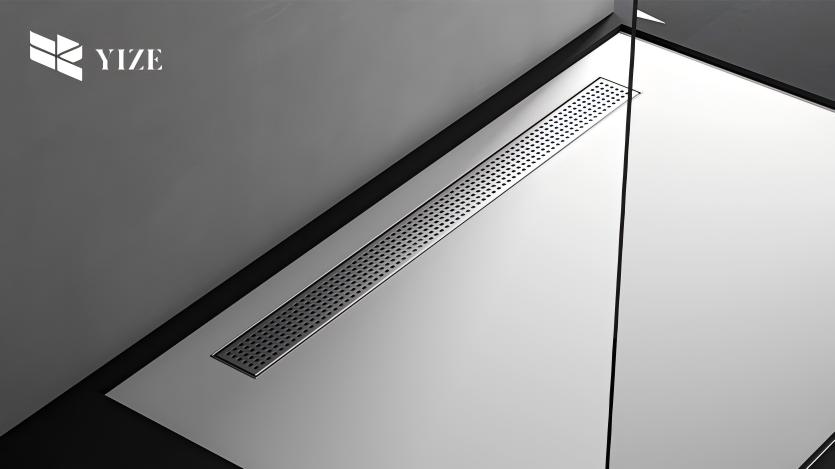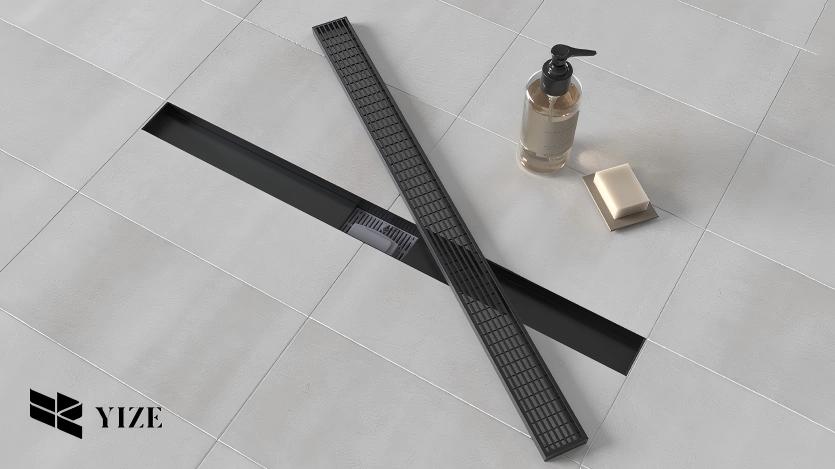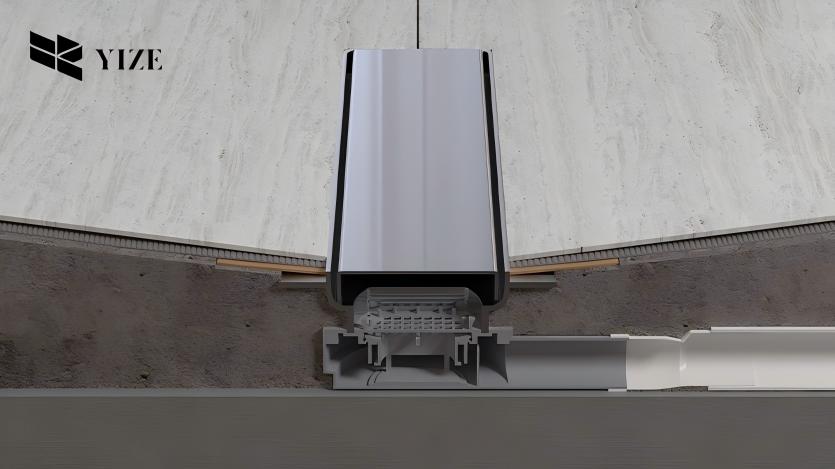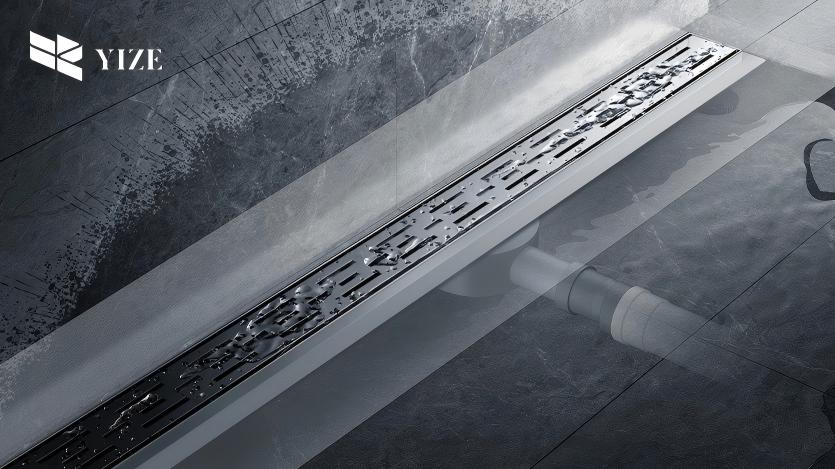I. Why does efficiency matter in Shower Drains?
It’s 2025, and your bathroom isn’t just about aesthetics anymore. It’s about efficiency: how well your systems manage water, resist clogs, support cleaning, and blend into your lifestyle. One of the most underrated parts of that setup? Your shower drain.

Shower drains don’t usually get the spotlight, but maybe they should. That little strip (or any other shape for that matter) on your floor does a lot more than you think. These days, the best ones aren’t just about flushing water away. They help keep your space cleaner, last longer without fuss, and even work better with eco-friendly plumbing systems.
If you’re redoing your bathroom or building from scratch, the drain isn’t something to wing at the last minute. A smart choice now can save you from gunky clogs, weird smells, or design regrets later.
II. The Winner: Linear Shower Drains
What it is:
A linear shower drain is a long, narrow drain that usually sits along one edge of the shower, though some styles go straight down the center. You see, unlike old-school center drains that need the floor to slope in four directions, linear drains only need one gentle slope. That makes the whole setup easier to build, tile, and keep clean. They also give your bathroom a sleek, modern vibe and are perfect for large tiles or walk-in, barrier-free showers. It’s function and style rolled into one smart upgrade.
It’s no surprise they’ve become the go-to choice for many homeowners and designers in 2025. Acquiring a four-way slope, linear drains only need the floor sloped in one direction.
Why it’s efficient:
- Faster water flow: With a larger surface area, linear drains move water faster and reduce pooling.
- Easier cleaning: Fewer grout lines mean less build-up and bacteria.
- Low-profile design: They sit flush with the floor, with no step-ups or lips; making them great for walk-in showers and aging-in-place designs.
- Tile flexibility: They accommodate large-format tiles, reducing tile cuts and installation time.
What’s new in 2025:
Many linear drains now include hair traps with easy access, anti-odor features, and splash guards that redirect water back toward the drain. Plus, brands have improved stainless steel finishes to resist corrosion even more effectively.
III. What about Hidden or Wall-Mounted Drains?
Hidden or invisible drains; often integrated along the wall or tucked into the baseboard, have exploded in popularity among high-end designs. These are also efficient, especially in:
- Aesthetic minimalism: Nothing clutters the look of the floor.
- Barrier-free setups: Ideal for accessible bathrooms or spa-style showers.
But while they win on design, they sometimes require more complex installation and regular maintenance to stay efficient. So unless you’re going all-in on design, a well-installed linear drain still wins for most homes.
IV. Drain Efficiency Factors to look for this year
Here’s what actually makes a shower drain “efficient” in 2025:

- Water flow rate: Can it handle high-pressure showers or rain-style heads?
- Easy maintenance: Removable grates and built-in hair catchers make cleaning simple.
- Clog prevention: Narrow grates or poor slopes cause buildup. Look for wide channels and anti-backflow designs.
- Durability: High-grade stainless steel or PVC with a secure waterproof membrane.
- Compatibility: Works well with your floor tiles, waterproofing system, and slope design.
V. What are the new technologies in Shower Drains? (Yes, Really)
In 2025, we’re seeing smarter plumbing all around the home, and drains are no exception. New models include:
- Smart odor-blocking valves that close when not in use
- Integrated LED indicators for cleaning reminders
- Magnetic grates for easy removal
- Recyclable and sustainable materials for eco-conscious builds
These additions boost long-term performance and reduce maintenance, which all feed into what we now define as “efficiency.”
VI. Common mistakes that kill the efficiency of your shower drain

Even the best drain won’t work well if:
- The floor isn’t sloped properly
- You skip waterproofing the base and flange
- Materials don’t match, causing corrosion (e.g., copper touching steel)
- Drain placement doesn’t match the trap or plumbing
Tip: Don’t DIY unless you know how to align the drain, slope the floor correctly (¼” per foot), and seal the membrane. One bad step = leaks, smells, and regrets.
VII. Final verdict: Most Efficient Shower Drain 2025
If we’re picking one winner for 2025, the linear shower drain checks all the boxes; especially for modern, accessible, and low-maintenance showers.
But no matter the type, remember: the most efficient drain is the one that’s installed correctly, cleaned regularly, and suited to your specific bathroom layout.
VIII. Frequently Asked Questions

Q1: Are linear drains better than center drains?
In most modern bathrooms, yes. Linear drains offer faster drainage, better compatibility with large tiles, and a sleeker look. However, center drains are more budget-friendly and still effective when installed properly.
Q2: What size linear drain do I need?
It depends on your shower size. A general rule: the drain should be almost as wide as the wall it’s installed against. A 36″ linear drain works for most standard showers.
Q3: Do linear drains clog more often?
Actually, no. Because they have wider channels and better flow, they’re less likely to clog; especially when they include built-in hair traps.
Q4: Can I install a linear drain myself?
It’s possible for experienced DIYers, but keep in mind you’ll need to adjust the slope, waterproof the membrane, and align the drain with the waste pipe correctly. If not done right, leaks and poor drainage follow.
Q5: What’s the best material for shower drains in 2025?
When it comes to materials, 304 or 316 stainless steel is still the go-to for strength and rust resistance; it’s tough, reliable, and built to last. On a tighter budget? ABS plastic or PVC can get the job done too, as long as the waterproofing around it is done properly. It’s not just about the drain itself, it’s how well everything around it is sealed that really counts.
IX. Conclusion
Today’s top picks, especially linear drains, strike the perfect balance between performance, style, and easy upkeep. So if you’re giving your bathroom a refresh, don’t treat the drain like an afterthought. Pick one that fits your space and works hard behind the scenes.
